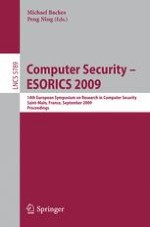2009 | Book
Computer Security – ESORICS 2009
14th European Symposium on Research in Computer Security, Saint-Malo, France, September 21-23, 2009. Proceedings
Editors: Michael Backes, Peng Ning
Publisher: Springer Berlin Heidelberg
Book Series : Lecture Notes in Computer Science
